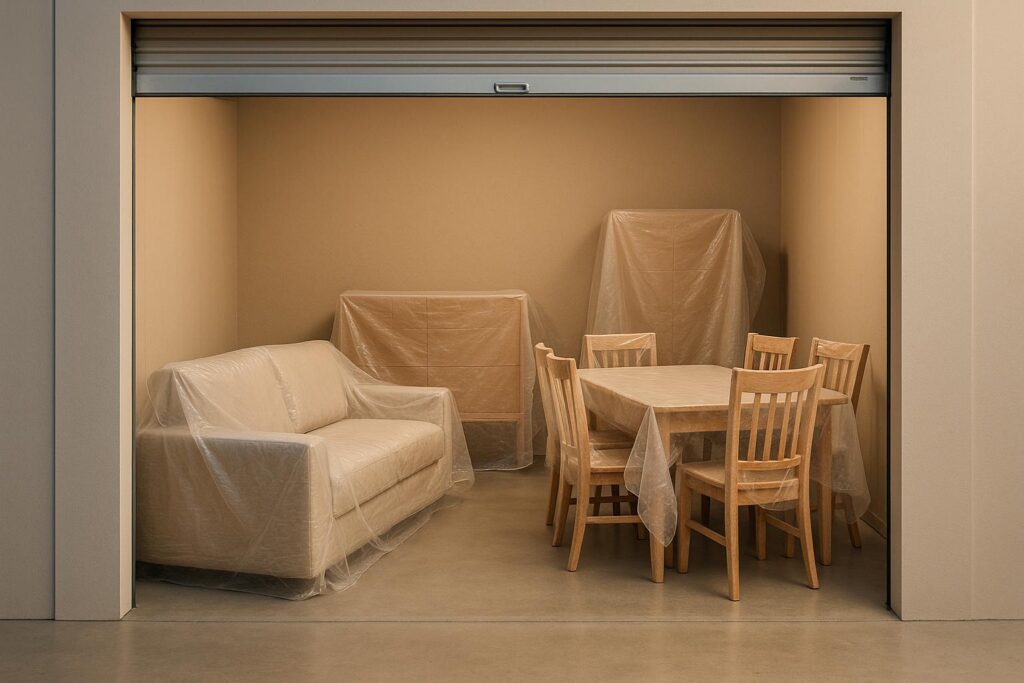Renovating your home? Avoid damage to your furniture by storing it safely. Dust, moisture, and paint can ruin fabrics, wood, and delicate finishes. Here’s how to protect your furniture during the process:
- Clean Before Storing: Remove dust and dirt to avoid scratches or stains.
- Disassemble Large Items: Save space and reduce the risk of damage by taking furniture apart.
- Use Breathable Covers: Avoid plastic, which traps moisture; opt for cotton sheets or furniture blankets instead.
- Organise Your Storage Space: Elevate furniture on pallets and arrange items for easy access.
- Check Regularly: Inspect for damp, pests, or damage and adjust conditions as needed.
For larger projects, consider professional storage facilities with security features. Plan ahead by measuring your furniture, calculating the required storage space, and accounting for potential delays in your renovation timeline.
| Storage Unit Size | Capacity | Ideal For |
|---|---|---|
| 25–50 sq ft | 1 room | Small furniture sets and boxes |
| 75–150 sq ft | 2–3 rooms | Living room and bedroom furniture |
| 200–300 sq ft | 4–5 rooms | Entire house contents |
1. Planning Your Storage Requirements
Careful planning is key to keeping your furniture both safe and accessible, while also saving you time and money. Start by making a detailed list of every item you need to store – this will help you understand your space requirements and avoid any surprises.
1.1 Making a Complete Furniture List
The first step is creating a thorough inventory. This helps determine exactly how much space you’ll need and ensures nothing gets overlooked. For each piece of furniture, make a note of:
- Exact dimensions: Measure at the widest points, including irregular shapes or protrusions.
- Disassembly potential: Can the item be taken apart to save space?
- Current condition: Record any existing damage to keep track of its state.
Here’s a quick guide to some common furniture types and their storage needs:
| Furniture Type | Storage Considerations |
|---|---|
| Upholstered Items | Breathable covers |
| Wooden Furniture | Stable temperature, protection from moisture |
| Antiques/Valuables | Extra protection, specialised wrapping |
| Electronics | Use original packaging if available |
Once you’ve got your list, think about how long you’ll need storage. This is especially important if your timeline involves renovations, which often take longer than expected.
1.2 Planning Storage Length
Renovation projects can sometimes stretch beyond their initial estimates, so it’s wise to plan for potential delays. Keep these factors in mind:
- The size and complexity of your project
- Contractor schedules and availability
- Delivery times for materials
- Possible weather-related interruptions
- Time required for building permits to be approved
"Estimating the storage unit size you need will save you time and money." – Kurt Manwaring, Move.org
To get the most out of your storage, check out our storage solutions guide. As a general rule, a medium storage unit (75–150 square feet) can hold furniture from up to three rooms. Larger units (200–300 square feet) are suitable for the contents of up to five rooms.
Most reliable furniture storage Wirral facilities offer flexible contracts that can adapt to your project’s timeline. Opting for a longer rental period upfront is often more budget-friendly than extending your contract multiple times. Proper timing ensures your furniture stays safe and secure until your renovations are complete.
2. Finding the Best Storage Option
Picking the right storage solution is a big step in keeping your furniture safe during renovations. You’ll want a facility that strikes the perfect balance between security, and space.
2.1 Key Security Features
When storing furniture, security should be non-negotiable. According to the British Security Industry Association (BSIA), 85% of storage facilities now use advanced access control systems. Here’s what to look for in a secure storage facility:
- Electronic gate access: Individual PIN codes ensure only authorised access.
- CCTV coverage: Comprehensive surveillance for peace of mind.
- Motion-sensor lighting: Keeps the facility safe and well-lit.
- High-security locks: Disc or cylinder locks for added protection.
- Individual unit alarms: Alerts for unauthorised access.
- On-site staff: Security personnel for an extra layer of safety.
Want to see these security features in action? Visit our furniture storage Wirral facility for a closer look.
2.2 Calculating Unit Size Needs
Choosing the right storage unit size is all about balancing cost and space. Here’s a quick guide to help you figure out what you need:
| Unit Size (sq ft) | Typical Capacity | Ideal For |
|---|---|---|
| 25–50 | 1 room | Small furniture sets and boxes |
| 75–150 | 2–3 rooms | Living room and bedroom furniture |
| 200–300 | 4–5 rooms | Entire house contents |
Here’s how to calculate your space requirements:
- Measure your largest items: Get the dimensions of your biggest furniture pieces.
- Add 30% extra space: This ensures you have room to move around and access items.
- Think vertically: Most units are about 2.4m tall, so stack items where possible.
- Disassemble larger items: If possible, take apart furniture to save space.
For most renovation projects, medium-sized units (75–150 sq ft) work well, offering enough room for multiple rooms’ worth of furniture while keeping everything accessible.
Need help deciding? Use our storage calculator to find the perfect unit size for your project. The right fit means your furniture stays safe and easy to reach.
3. Getting Furniture Ready for Storage
Preparing your furniture properly before putting it into storage is essential to keep it in good condition during your renovation. Here’s how to make sure your pieces stay safe and sound.
3.1 Pre-Storage Cleaning Steps
Cleaning your furniture before storage is a must, but the method depends on the material. Here’s a quick guide:
| Furniture Type | Cleaning Method | Products to Use |
|---|---|---|
| Wood | Wipe gently with a microfibre cloth | Mild soap solution or wood cleaner |
| Upholstery | Vacuum thoroughly and treat any spots | Commercial upholstery cleaner |
| Leather | Wipe gently and condition the surface | Leather cleaner and conditioner |
| Glass/Metal | Use streak-free cleaning techniques | Glass cleaner or mild detergent |
For stubborn mildew on wooden surfaces, mix equal parts warm water and white vinegar. Always test cleaning solutions on a hidden spot first to avoid accidental damage. Once cleaned, consider disassembling larger items to make them easier to store.
3.2 Taking Apart Large Furniture
Disassembling big furniture pieces can save space and prevent damage. Here’s how to do it right:
- Take Photos First: Snap pictures of the furniture from multiple angles before you start taking it apart. This makes reassembly much easier later.
- Keep It Organised: Place screws, bolts, and other small parts in labelled sealable bags, and attach these to the corresponding furniture pieces. If you have the original assembly instructions, store them with the furniture.
- Handle Fragile Elements Carefully: Remove delicate parts, like glass panels or decorative accents, first. Wrap these items separately to avoid breakage.
Once disassembled, make sure each component is properly protected before putting it into storage.
3.3 Proper Furniture Protection
Using the right materials to protect your furniture during storage is key. Follow these tips based on the type of furniture:
- Wooden Furniture: Wrap pieces in breathable cotton sheets or furniture blankets. Avoid using plastic, as it can trap moisture and cause damage.
- Upholstered Items: Ensure the fabric is clean and completely dry. Cover with a ventilated material to keep it fresh.
- Glass Components: Wrap glass items in bubble wrap for cushioning and label them as fragile to prevent accidents.
For more advice on how to protect your belongings during a renovation, check out our Self Storage Solutions page.
sbb-itb-d9c64f0
4. Setting Up Your Storage Space
Once your furniture is clean and prepped, it’s time to organise your storage area. These methods will help you make the most of your space while keeping your furniture safe.
4.1 Furniture Placement Guide
Start by preparing the floor. Lay down plastic sheeting to guard against moisture, then elevate your furniture using wooden pallets or metal risers. This simple step can prevent damp damage over time.
Here’s a quick reference for placing different furniture types:
| Furniture Type | Placement Method | Special Considerations |
|---|---|---|
| Heavy Items | Place against the back wall | Leave room for air circulation |
| Sofas & Chairs | Stand upright on risers | Avoid stacking anything on top |
| Tables | Store flat or on edge | Ensure the placement is stable |
| Mattresses | Lay flat on a raised platform | Don’t store upright to prevent warping |
4.2 Easy Access Planning
To make retrieval simple during renovations, divide your storage unit into three zones:
- Front Zone (Immediate Access): Place frequently used items here and keep a clear pathway for easy access.
- Middle Zone (Occasional Access): Store medium-sized items here, ensuring there’s enough space to reach them comfortably.
- Back Zone (Long-term Storage): Use this area for larger or less-needed items. Keep them elevated and well-protected.
This zoning approach helps you stay organised and reduces the hassle of rummaging through your storage.
4.3 Moisture and Pest Prevention
Keeping your furniture safe from damp and pests is crucial, especially for long-term storage. Regular checks and preventative measures can save you from unpleasant surprises.
- Monitor humidity levels with moisture-detection strips and address any dampness immediately.
- Use natural pest repellents like cedar blocks or lavender-soaked cotton balls.
- Wrap furniture, particularly upholstered pieces, in plastic to shield them from moisture and pests.
- Inspect your unit periodically to ensure everything remains in good condition.
5. Regular Storage Maintenance
Keeping a close eye on your stored furniture during renovations helps ensure it stays in great condition. Setting up a regular maintenance routine can go a long way in protecting your treasured pieces.
5.1 Monthly Checks
A consistent schedule for inspecting your stored furniture can help you spot and address potential issues early. Here’s a handy guide to follow:
| Inspection Area | What to Check | Action Required |
|---|---|---|
| Wood Furniture | Warping, cracking | Adjust humidity levels and rotate items |
| Upholstered Items | Mould or mildew spots | Clean affected areas and improve ventilation |
| Metal Components | Rust formation | Apply a protective coating and reduce moisture |
| Storage Environment | Musty odours, dampness | Add dehumidifiers and check seals |
| Protective Covers | Tears or loose wrapping | Replace damaged covers and resecure wrapping |
Don’t forget to inspect less obvious areas, like corners and undersides, for hidden moisture. If you find any problems, tackle them immediately. Alongside these checks, managing humidity is key to maintaining the right storage conditions.
5.2 Controlling Storage Humidity
Humidity control plays a huge role in protecting furniture during long-term storage. Aim for a humidity level of around 50% and keep temperatures between 10°C and 24°C for the best results.
Here’s how to keep humidity in check:
- Use a digital hygrometer to monitor moisture levels.
- Place moisture absorbers strategically throughout the storage space.
- Try charcoal briquettes in open containers to cut down on moisture and odours naturally.
- Position desiccant packets near items like wooden furniture that are more sensitive to moisture.
"Early detection of these problems is a must for minimising the extent and cost of the damage", says Tom Laurenzi from Delmhorst Instrument Co.
As part of your monthly routine, review and adjust your moisture control tools to ensure everything stays in balance. For more tips on creating the perfect storage environment, check out our self storage insights.
Conclusion: Safe Furniture Storage During Renovations
Taking the time to plan and carefully store your furniture during renovations can make a world of difference. By securing your belongings in a safe environment, you not only protect their condition but also create a more organised and efficient workspace, reducing the chance of accidental damage.
If you’re considering professional options, facilities like furniture storage Wirral offer secure environments with advanced security.
To ensure your furniture remains in top shape during renovations, here are some practical steps to follow:
- Clean and disassemble: Remove dust and dirt, and take apart larger furniture to save space and prevent strain on delicate parts.
- Use protective covers: Wrap items in suitable materials like blankets or plastic to guard against scratches and moisture.
- Check storage conditions: Regularly monitor the environment to ensure it remains dry, clean, and free of pests.
- Label and organise: Keep everything easy to locate by using clear labelling and a logical arrangement.
Whether you’re updating a single room or tackling a full-scale property renovation, proper storage is key to preserving your furniture and keeping your project running smoothly. For more tips and solutions, visit our self storage solutions page.
FAQs
How can I protect my furniture from pests and damp while in storage?
To protect your furniture from pests and damp while in storage, start by wrapping upholstered items in plastic or using specially designed covers. This creates a barrier that helps shield them from potential damage. Make sure everything is thoroughly cleaned and checked for pests beforehand to avoid bringing any unwanted guests into the storage space.
To further safeguard your furniture, consider elevating it off the ground using pallets or shelving. This not only helps protect against possible leaks but also improves airflow around the items. For added protection, place moisture absorbers like silica gel or a dehumidifier in the unit to minimise the risk of mould and mildew.
Taking these precautions can help keep your furniture in great condition throughout its time in storage.
What should I consider when selecting the right size storage unit for my furniture during a renovation?
When deciding on the best storage unit size for your furniture during a renovation, start by figuring out how much space you’ll need. Measure larger items like sofas, wardrobes, or tables, and don’t forget to account for smaller belongings such as boxes. This will give you a clearer idea of the total space required.
It’s also important to think about how often you might need to access your items. If you’ll be retrieving things regularly, choose a unit that offers some extra space so you can organise everything neatly and reach what you need without hassle. Planning this out carefully will help keep your furniture safe and make the process smoother throughout your renovation.



